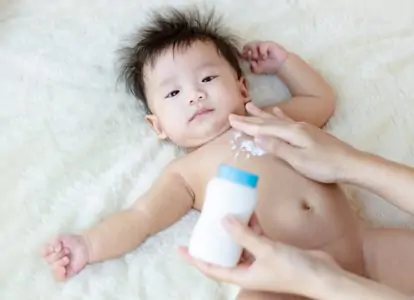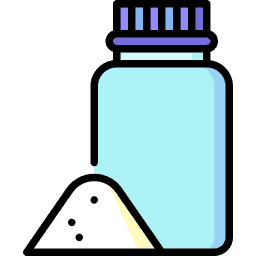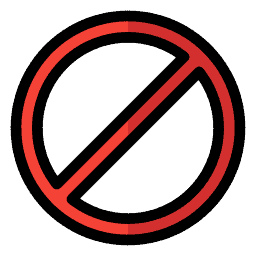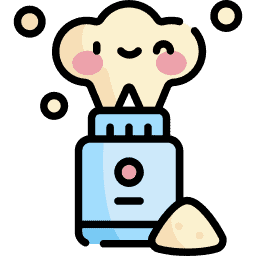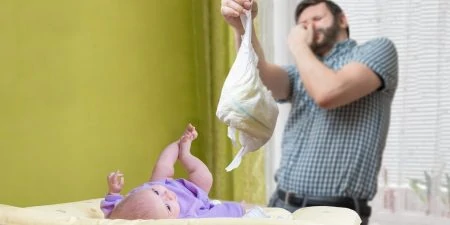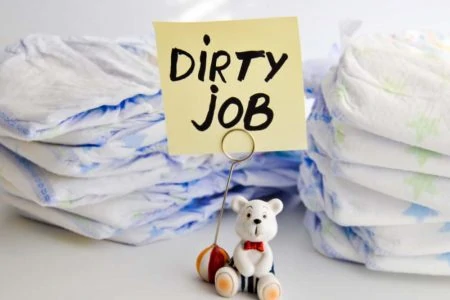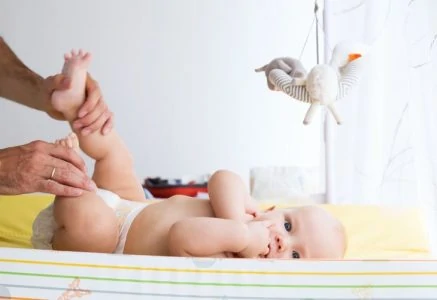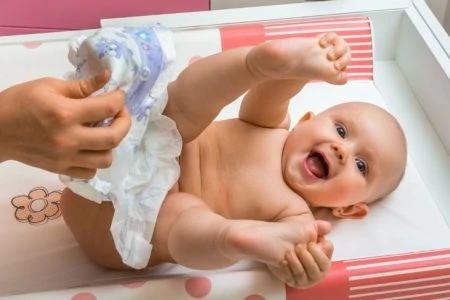Is baby powder safe? It used to be a nursery staple. We all know that classic white bottle and the distinct “clean baby” smell. But recently, a string of lawsuits and scary headlines has turned this everyday essential into a questionable parenting choice.
It is easy to get overwhelmed by rumors and panic. So, before you toss everything in the diaper bag, let’s look at the science. Why are experts warning against it? Is cornstarch any better than talc? And if we can’t use powder, how do we keep those little bottoms dry?
Here is everything you need to know about baby powder safety and the best alternatives for preventing diaper rash.
Key Takeaways
- Talc risks are real: Talc-based powders have faced scrutiny due to potential asbestos contamination and links to ovarian cancer.
- Inhalation is the main danger: The American Academy of Pediatrics (AAP) advises against all baby powders (even cornstarch) because the fine particles can damage a baby’s lungs.
- Creams are safer: Barrier creams, petroleum jelly, and simply drying the skin thoroughly are safer, more effective ways to prevent diaper rash.
- J&J has switched: Johnson & Johnson discontinued talc-based baby powder globally in 2023, switching to cornstarch-based formulas.
What’s in Baby Powder?
Who doesn’t love that fresh fragrance? It smells like a clean, cozy baby. But that snow-white dust isn’t as innocent as it looks.
Before we decide if it is safe, we need to know what is actually inside the bottle. Not all powders are created equal. The market is split into two main camps: talc-based powders (the controversial ones) and non-talc alternatives.
What Is Talc Baby Powder?
Grandma’s go-to powder was made from talc. This is a mineral composed of magnesium, silicon, and oxygen. It is great at absorbing moisture and cutting down on friction, which is why it was popular for so long.
However, geology poses a problem here. Talc deposits often form right next to asbestos, a known carcinogen. If the talc isn’t purified perfectly during mining, there is a risk of cross-contamination.
According to the American Cancer Society, talc that contains asbestos is generally accepted as being able to cause cancer if inhaled (1). While cosmetic-grade talc is supposed to be free of asbestos, testing over the years has been inconsistent, leading to major recalls and lawsuits.
What Is Non-Talc Baby Powder?
Because of the risks associated with talc, many brands have pivoted. You will now see plenty of “talc-free” labels on drugstore shelves.
The most common base for these is cornstarch. It is a food-grade ingredient that handles moisture well. You might also see powders made from:
- Baking soda: Often mixed with other starches for odor control.
- Kaolin clay: A gentle clay used in cosmetics.
- Arrowroot or Tapioca starch: Natural plant-based absorbents.
But is “talc-free” automatically safe? That is the tricky part. While you avoid the asbestos risk, you still have to deal with the dust itself.
Is Baby Powder Safe for Babies?
The short answer? Most doctors say no.
The American Academy of Pediatrics (AAP) specifically warns against using baby powder of any kind (2). The risk isn’t just about cancer; it is about breathing.
When you shake that bottle during a diaper change, a cloud of fine particles fills the air. Your baby, lying right there on the changing table, breathes it in. This can irritate their tiny lungs and cause serious respiratory issues. This risk applies to both talc and cornstarch powders.
The Health Risks of Using Powder
The Food and Drug Administration (FDA) and other health organizations have spent years analyzing these products (3). Here is a breakdown of the two biggest concerns.
Lung Irritation and Breathing Trouble
The most immediate danger is inhalation. Doctors call this “Pulmonary Talcosis” when it involves talc, but any fine powder is problematic (4).
Babies have small, developing airways. Breathing in powder can lead to coughing, wheezing, and in severe cases, pneumonia or lung damage. It is hard to control where the dust goes, especially with a wiggly infant.
Ovarian Cancer Concerns
This is the big question that led to massive lawsuits. Does baby powder cause ovarian cancer?
The theory is that powder particles applied to the genital area could travel up through the reproductive system to the ovaries. The International Agency for Research on Cancer (IARC) classifies the perineal use of talc-based body powder as “possibly carcinogenic to humans” (5).
While the science is still debated, thousands of women successfully sued Johnson & Johnson, claiming long-term use contributed to their cancer. Given the potential risk, most parents agree: it simply isn’t worth it.
What to Use Instead of Baby Powder
You want to prevent diaper rash, but you want to skip the dust. Good news: the alternatives are actually more effective.
Here is the modern, safe routine for a rash-free bottom:
- Dry it out: Moisture is the enemy. Pat the baby’s skin completely dry with a towel or let them “air dry” for a minute before putting a new diaper on.
- Clean gently: Rinse with warm water or use an alcohol-free, fragrance-free wipe.
- Loosen up: Do not fasten the diaper too tightly; airflow helps keep skin healthy.
- Use a barrier cream: This is the gold standard. A thick layer of cream protects the skin better than a thin layer of powder.
If you need product recommendations to help you make an informed buying decision, stick to the classics. Vaseline Gentle Petroleum Jelly Blue Seal acts as a perfect shield against wetness. For active rashes, zinc oxide products like Desitin Daily Defense Baby Diaper Rash Cream soothe the skin and heal redness fast.
Pro Tip
Many parents rush to the pediatrician for diaper rash, but often the solution is simple. The key is catching it early. At the first sign of redness, switch to water-only rinsing (skip the wipes) and apply a thick layer of barrier cream at every single change.
Baby Powder FAQs
Here are the most common questions we get regarding powder safety and legality.
Letting the Dust Settle
Is baby powder safe? The consensus is clear: the risks outweigh the benefits. Between the potential for lung irritation and the scary history of asbestos contamination, it is better to leave the powder on the shelf.
Keeping your baby dry doesn’t require a cloud of dust. A good towel dry and a quality barrier cream are all you need.
Does the little one already have a diaper rash? It happens! That’s why you’ve got to know our 7 Simple Steps to Applying Diaper Cream.
